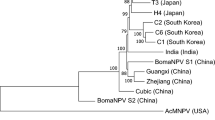Abstract
Open reading frame (ORF) 126 (Bm126) of Bombyx mori nucleopolyhedrovirus (BmNPV) is not essential for viral replication, and two subtypes of this gene have been identified in China. The Bm126-SX subtype encodes a protein with a simple amino acid duplication/insertion relative to the Bm126-GD subtype; however, significant differences in the cytopathic effect and infectivity of viruses carrying these variant genes have been observed. To elucidate the cause of these differences, differential gene expression analysis was performed at the early stage of infection with viruses harbouring variants of Bm126. Differential expression was observed for 103, 209, and 313 host genes and 9, 44, and 67 viral genes in vGD126 samples relative to the control samples (vSX126) at 6, 12, and 24 h postinfection, respectively. These results indicated that the duplication/insertion in Bm126 altered the viral expression pattern. The differentially expressed host genes were found to be related to ribosome, spliceosome, and proteasome pathways, and several factors involved in signal transduction were also identified. The differential expression of these viral and host genes was confirmed by qPCR. This study indicates that the amino acid duplication/insertion in the Bm126 gene has a biological function related to the regulation of viral gene expression and serves as a basis for further characterization of Bm126 gene function.



Similar content being viewed by others
References
Jiang L, Xia Q (2014) The progress and future of enhancing antiviral capacity by transgenic technology in the silkworm Bombyx mori. Insect Biochem Mol Biol 48:1–7
Gomi S, Majima K, Maeda S (1999) Sequence analysis of the genome of Bombyx mori nucleopolyhedrovirus. J Gen Virol 80(Pt 5):1323–1337
Ono C et al (2012) Phenotypic grouping of 141 BmNPVs lacking viral gene sequences. Virus Res 165(2):197–206
Hao B et al (2009) Variants of open reading frame Bm126 in wild-type Bombyx mori nucleopolyhedrovirus isolates exhibit functional differences. J Gen Virol 90(Pt 1):153–161
Beperet I et al (2015) The “11K” gene family members sf68, sf95 and sf138 modulate transmissibility and insecticidal properties of Spodoptera frugiperda multiple nucleopolyhedrovirus. J Invertebr Pathol 127:101–109
Audic S, Claverie JM (1997) The significance of digital gene expression profiles. Genome Res 7(10):986–995
Xiang LX et al (2010) Deep sequencing-based transcriptome profiling analysis of bacteria-challenged Lateolabrax japonicus reveals insight into the immune-relevant genes in marine fish. BMC Genom 11:472
Sagisaka A et al (2010) Genome-wide analysis of host gene expression in the silkworm cells infected with Bombyx mori nucleopolyhedrovirus. Virus Res 147(2):166–175
Salem TZ et al (2011) Comprehensive analysis of host gene expression in Autographa californica nucleopolyhedrovirus-infected Spodoptera frugiperda cells. Virology 412(1):167–178
Xue J et al (2012) Dynamic interactions between Bombyx mori nucleopolyhedrovirus and its host cells revealed by transcriptome analysis. J Virol 86(13):7345–7359
Morrissy AS et al (2009) Next-generation tag sequencing for cancer gene expression profiling. Genome Res 19(10):1825–1835
Gene Ontology C (2008) The gene ontology project in 2008. Nucleic Acids Res 36(Database issue):D440–D444
Kanehisa M (2002) The KEGG database. Novartis Found Symp 247:91–101 (discussion 101–3, 119–28, 244–52)
Benjamini Y et al (2001) Controlling the false discovery rate in behavior genetics research. Behav Brain Res 125(1–2):279–284
Lua LH et al (2002) Phenotypic and genotypic analysis of Helicoverpa armigera nucleopolyhedrovirus serially passaged in cell culture. J Gen Virol 83(Pt 4):945–955
Katsuma S et al (1999) Characterization of the 25 K FP gene of the baculovirus Bombyx mori nucleopolyhedrovirus: implications for post-mortem host degradation. J Gen Virol 80(Pt 3):783–791
Fan HW et al (2012) Genome of a Bombyx mori nucleopolyhedrovirus strain isolated from India. J Virol 86(21):11941
Sabol I et al (2008) Identification of a novel human papillomavirus type 16 E1 gene variant with potentially reduced oncogenicity. J Med Virol 80(12):2134–2140
Sabol I et al (2012) Characterization and whole genome analysis of human papillomavirus type 16 e1–1374^63nt variants. PLoS One 7(7):e41045
Perdue ML et al (1997) Virulence-associated sequence duplication at the hemagglutinin cleavage site of avian influenza viruses. Virus Res 49(2):173–186
Kim HJ, Bar-Sagi D (2004) Modulation of signalling by Sprouty: a developing story. Nat Rev Mol Cell Biol 5(6):441–450
Katsuma S, Mita K, Shimada T (2007) ERK- and JNK-dependent signaling pathways contribute to Bombyx mori nucleopolyhedrovirus infection. J Virol 81(24):13700–13709
Jin S et al (2014) Identification of a new Sprouty protein responsible for the inhibition of the Bombyx mori nucleopolyhedrovirus reproduction. PLoS One 9(6):e99200
Fischer KD, Tedford K, Penninger JM (1998) Vav links antigen-receptor signaling to the actin cytoskeleton. Semin Immunol 10(4):317–327
Huang J et al (2014) Entry of Bombyx mori nucleopolyhedrovirus into BmN cells by cholesterol-dependent macropinocytic endocytosis. Biochem Biophys Res Commun 453(1):166–171
Acknowledgements
This work was funded in part by the National Science Foundation of China (31101766, 31670152), the Natural Science Foundation of Jiangsu Province (BK20151321, BK20161365), and the Scientific Research Foundation for Returned Overseas Chinese Scholars, State Education Ministry (2015).
Author information
Authors and Affiliations
Corresponding author
Ethics declarations
Conflict of interest
The authors declare that they have no conflict of interest.
Ethical approval
This article does not contain any studies with human participants or animals performed by any of the authors.
Consent
All authors have seen and agree with the contents of the manuscript.
Additional information
Handling Editor: T. K. Frey.
Publisher's Note
Springer Nature remains neutral with regard to jurisdictional claims in published maps and institutional affiliations.
Electronic supplementary material
Below is the link to the electronic supplementary material.
Rights and permissions
About this article
Cite this article
Huang, J., Li, J., Cheng, C. et al. An amino acid duplication/insertion in the Bm126 gene of Bombyx mori nucleopolyhedrovirus alters viral gene expression as shown by differential gene expression analysis. Arch Virol 164, 831–838 (2019). https://doi.org/10.1007/s00705-018-04144-2
Received:
Accepted:
Published:
Issue Date:
DOI: https://doi.org/10.1007/s00705-018-04144-2




